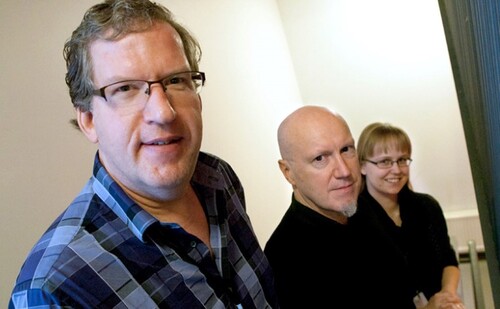-
-
Par GUETTEURNORDIQUE le 16 Novembre 2016 à 08:12
Finland invests in printing the Internet of Things - to avoid a global environmental nightmare.
FiDiPro Professor Paul Berger, Professor Donald Lupo and doctoral student Suvi Lehtimäki are developing printed electronic components for the Internet of Things.
Tampere University of Technology.
While vendors are in a mad rush, exploring the opportunities of IoT for the business, and industries are dragging heels on its actual implementation, mainstream IoT community seems to almost completely overlook one issue – the challenges IoT has brought to the environment.
The problem may not be obvious now, but keeping in mind that by 2021 IoT is expected to encompass 200 billion interconnected devices with a silicon chip and a battery stuck on each of them, stemming the tide of e-waste can become a Herculean task. According to United Nations University estimates reported by ITU, 53 million metric tons of e‑waste were disposed of worldwide in 2013. With the pervasiveness of IoT, the production of e‑waste is predicted to accelerate.
As a sustainable, energy-autonomous system.
Ahead of many other countries, Finland has been looking to avoid this environmental nightmare by boosting sustainable research and development of wireless technology.
Tampere Region has been identified by the Finnish Government as the key one for the implementation of the country’s Cleantech Strategy. Regionally, the Kolmenkulma Eco-Industrial Park has a central role in the implementation of this strategy, along with Tarastenjärvi Waste Management area.
Pirkko Eteläaho, Development Manager, Cleantech at Tampere Region Economic Development Agency Tredea, specifies that the sustainable development of the city of Tampere and Tampere Region aims to boost green innovations in every sector of cleantech - including IoT as a cross-sectoral theme.
“So far there’s been little discussion about what is needed to practically implement the IoT,” says Donald Lupo, Professor in the Department of Electronics and Communications Engineering at Tampere University of Technology. “Usually it’s assumed that all Internet-enabled devices will be equipped with a battery, but we don’t think that’s a sustainable approach. Everything is going to 4G, 5G, 10G, bigger, faster, better. But the higher the frequency band, the more energy you need. However, once you think of IoT as a sustainable, energy-autonomous system, you also have to think of how to minimize the energy.”
PAUL - a project for printing clean IoT.
Professor Donald Lupo together with his colleagues Professor Paul Berger of Ohio State University and Professor Mikko Valkama are currently developing a technology platform for printed distributed smart objects that communicate wirelessly and need no external source of energy.
Their project is titled ‘Printed, energy-Autonomous UniversaL platform for multifunctional wireless sensors and devices’ (PAUL) and is funded by Tekes – The Finnish Funding Agency for Innovation.
The ambition of the project PAUL is to improve the ability to harvest energy from a variety of sources such as light, radio waves and motion and store it in printed supercapacitors that are non-toxic and unproblematic at end of life.
Printing will make possible a new generation of low-power and high-speed circuits. In addition to this, it can help reduce the use of chlorine trifluoride in electronic industry for ClF3 is one of the world's most dangerous chemicals - it can burn bricks or asbestos or concrete and 1 meter of dirt beneath that too.
“It’s not only the sustainability of the objects themselves but how they are being utilized also has a sustainability element,” says Professor Berger.
R&D consortium are a unique Finnish knowhow.
Tampere region has a wide network of companies and research institutions working closely together to develop environmentally-friendly technological solutions.
“We have a few companies that are involved in the project,” confirms Professor Berger. “And it’s mind-blowing to me still that this FiDiPro [a Finnish funding programme for top science & tech reseachers] project is basically three academics and 14 member companies. Why? In the USA the company wants to have full ownership over the intellectual property – it’s all or nothing. So you don’t have this type of consortiums, they are very rare. Why would they want to spend their time for the possibility that we might do something of interest to them?”
For example, Vincit, a company from Tampere, is taking part in the PAUL project. They are far end of the chain because they are a software systems development company but they want to understand how it works now so that they could be involved.
Professor Berger notes that working in conjunction with the industry is very important. “In the future, we will emphasise even more the exploitation of research results and concrete cooperation with companies,” says Director Kimmo Kanto from Tekes.
“Some of the companies give us feedback on what they think is useful and what they would like to see done or give us a reality check – what sort of standards should be and what will be required out there. One company has given us machine time; others provided us with the materials. Others promised to do it later on when we are ready to try some scale up. They follow the project and make their own contributions as well,” explains Professor Lupo.
Finland has a culture of collaboration towards societal improvement.
Professor Berger remarks that while in the USA most of the academic funding goes towards projects that have military applications, at the Finnish level there is a strong push to fund the initiatives that are going to lead to industrial use for the general public.
“There is a different culture here”, agrees Professor Lupo. “People are actually interested in working together to solve the problem. Plus there are more things happening here in the organic electronics field. There is a commitment from the university. The university, the people and the infrastructure down in the basement - that’s the more important ingredient. It’s the people that the university has invested in.”
“It is great to have such joint projects as PAUL in Tampere, where IoT - which helps making solutions greener - is also looked at from a greener perspective”, underlines Pirkko Eteläaho from Tredea.
The path to a cheap, clean and autonomous Internet of Things.
Another company from Tampere Confidex is the world’s leading supplier of high-performing contactless ticketing and RFID tag solutions and services. According to Timo Inkinen, Executive VP, Smart Identification, printed energy storages and harvesters are key components for wireless sensors in industrial Internet solutions. Thus, the company is actively involved in the PAUL project.
“PAUL project has generated valuable knowledge for Confidex, which would further strengthen Confidex’s position as the world’s leading supplier of high-performing contactless ticketing and NFC/RFID tag solutions and services. Furthermore, PAUL project has started important partnerships to develop novel flexible wireless sensors for future IoT applications. Even though Confidex has large global customer base, our R&D is located in Tampere, partly because of strong wireless technology knowhow and the industry in the area. Also, presence of Tampere University of Technology as project host will ensure availability of new talents in the future,” says Timo Inkinen.
As a result, successful completion of the project will open the path to a true Internet of Things that will cost very little, be placeable anywhere, and deserve the description “environmentally friendly”.
http://nordic.businessinsider.com/10-nordic-principles-for-a-hyperconnected-planet-2016-8/
 votre commentaire
votre commentaire
-
-
Par GUETTEURNORDIQUE le 15 Novembre 2016 à 08:42
What Happens to Your Body When You Drink Alcohol on a Plane?
Soon the holiday season will again be upon us and the numbers of leisure travelers descending on our airports will peak. You know the feeling all too well: excitement; finally having the time to make a journey you’ve looked forward to; visiting relatives in far-off countries; a long-awaited hiking break; or even just some quality time to read a good book…. Whatever, it’s a well-earned opportunity to cross off something nice from your ‘to do’ list!
On arriving at the airport, before boarding your plane, you have time to drop by one of the tax-free shops, after which you allow yourself the luxury of an alcoholic beverage. It’s finally time to relax. Then, on board your flight, shortly after take-off the stewardess offers you a welcome drink. Wow, now your journey is really underway! And I can totally relate to the mood.
But… what exactly happens to your body when you drink alcohol on a plane?
What happens when you drink alcohol?
After drinking an alcoholic beverage what’s known as blood alcohol content (BAC) takes between 30 to 60 minutes to peak and reach its maximum effect. Needless to say, consuming several alcoholic beverages during a short period of time can easily mean you are expecting your body to cope with more alcohol than your liver can process. In such a case the excess alcohol will travel through your bloodstream un-metabolized and unchanged. The concentration of alcohol in the blood, or BAC, will then increase.
As it travels through your bloodstream, the alcohol eventually reaches your brain, where it acts as a sedative and slows down transmissions and impulses between the nerve cells that control your ability to think and move. Although alcohol is a depressant, it also removes inhibitions, which explains the sometimes happy and other times aggressive behavior associated with drinking alcohol. It also increases the flow of fluid through your kidneys, increasing the likelihood of becoming dehydrated.
What happens when you drink alcohol on board a plane?
During a flight, the barometric pressure in the cabin of a plane is lower than it is in most places on earth. You can compare it with an altitude in the mountains of between 1,800 and 2,200 meters. This decreased pressure environment diminishes the body’s ability to absorb oxygen and it can produce light-headedness. We call this hypoxia. Generally speaking, this is not an issue but the feeling could be similar to the experience you have after drinking alcohol.
Therefore, if you drink alcoholic beverages during a flight you may notice it sooner, and so might the crew and other passengers if you drink too much. In other words, because of the lower level of oxygen in your blood, you may seem more drunk in the air than you would on the ground after consuming the same amount of alcohol. But, in fact, your BAC will show the same percentage as would be the case if you drank the same amount of alcohol on the ground under similar circumstances. A complicating factor is that the air in an aircraft is very dry and, coupled with the diuretic effect of drinking alcohol; you may become dehydrated much faster than you would on the ground.
So, to combat dehydration make sure you drink water with every alcoholic beverage. And minimize your intake of salty food, as this may have an adverse effect by making you more thirsty and encouraging you to drink at a faster rate.
What is KLM’s policy on serving alcohol on board?
Policies on serving alcohol on board differ per airline and destination. At KLM you can prepare for your trip and can even check out the menu (including beverages) of your specific flight beforehand.
The safety, security and comfort of passengers and crew are of the highest priority to airlines. Unruly behavior or acts by passengers, due to alcohol abuse/intoxication or otherwise, is an infringement of international law. The pilot in command of a flight is authorized to disembark or deliver an unruly passenger to a law-enforcement agency. Flight crew and cabin crew enjoy immunity from subsequent legal proceedings for any actions that they might have to take against an unruly passenger.
So, it’s better to be safe than sorry…and drink wisely on an aircraft.
Enjoy your trip!! (By Didi Aaftink).
 votre commentaire
votre commentaire
-
Par GUETTEURNORDIQUE le 14 Novembre 2016 à 07:48
 votre commentaire
votre commentaire Suivre le flux RSS des articles de cette rubrique
Suivre le flux RSS des articles de cette rubrique Suivre le flux RSS des commentaires de cette rubrique
Suivre le flux RSS des commentaires de cette rubrique









